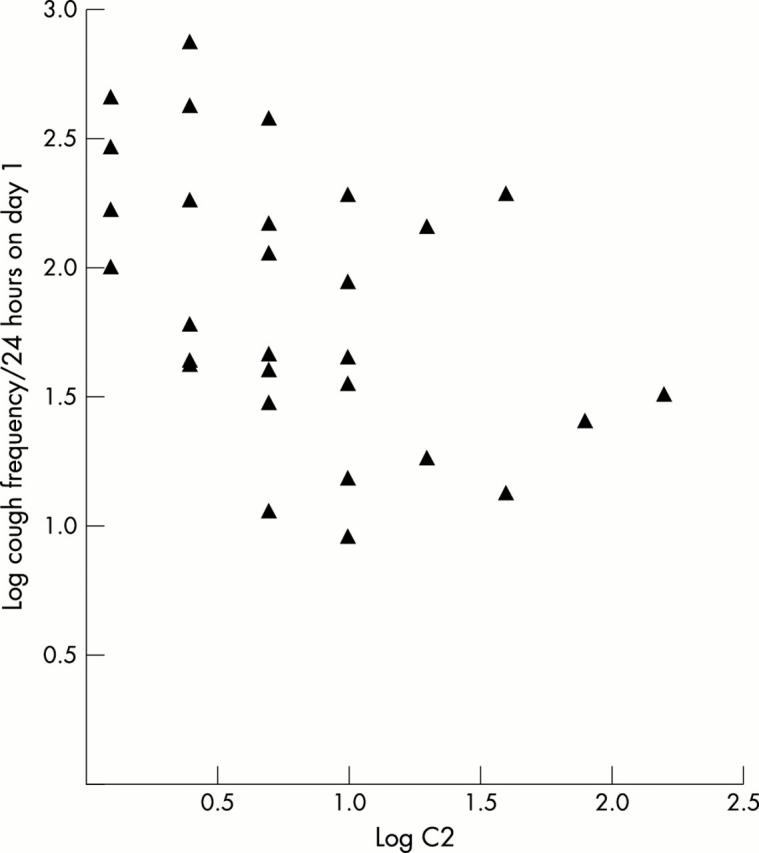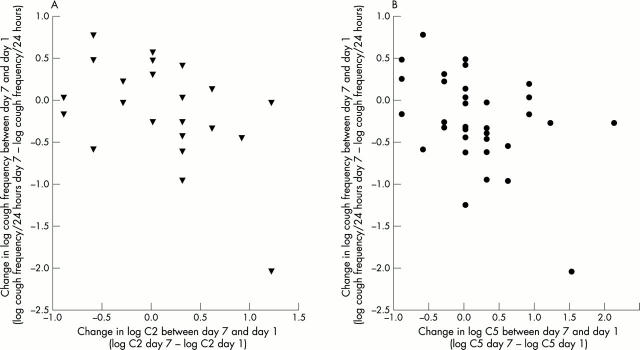Abstract
Background: In asthma, measurements of airway inflammation correlate poorly with clinical markers and airway hyperresponsiveness. While the relation between determinants of asthma severity is known, that for cough is unknown. We hypothesised that cough sensitivity changes relate to changes in cough scores and objectively measured cough frequency.
Aims: To examine the relation between commonly used outcome measurements of cough severity in children.
Methods: The concentration of capsaicin causing two and five or more coughs (C2 and C5 respectively), cough frequency objectively measured using an ambulatory cough meter, and parent and child recorded subjective cough scores were determined in 40 children with recurrent cough on two occasions.
Results: On occasion one, log cough frequency significantly correlated with parent and child recorded log cough score (rs = 0.32, p = 0.05; and rs = 0.32, p = 0.046 respectively) and significantly negatively correlated with log C2 (rs= -0.5, p = 0.005). Subjective cough scores did not relate to either C2 or C5. On occasion two, the relation between cough frequency and C2 and C5 measures was lost, but C2 had a weak but significant relation to parent recorded cough score (rs = -0.38, p = 0.047). When the changes in the log values were determined, C5 but not C2 significantly related to cough frequency.
Conclusion: In children, measures of cough sensitivity have a weak relation with cough frequency. Subjective cough scores have a stronger and consistent relation with cough frequency. These cough severity indices measure different aspects of cough. The choice of indices depends on the reason for performing the measurement.
Full Text
The Full Text of this article is available as a PDF (146.7 KB).
Figure 1 .

Log cough frequency measured using an ambulatory cough meter significantly correlated with log C2 (concentration of capsaicin required to stimulate 2–4 coughs); rs = -0.5 (95% CI -0.74 to -0.18), p = 0.005.
Figure 2 .
The change in measurements of the two occasions the tests were undertaken. (A) The correlation between the change in log cough frequency with change in log C2 was just outside statistical significance, rs = -0.4 (95% CI -0.7 to 0.02), p = 0.06. (B) Change in log cough frequency significantly correlated with change in log C5, rs = -0.38 (95% CI -0.63 to -0.07), p = 0.03.
Selected References
These references are in PubMed. This may not be the complete list of references from this article.
- Archer L. N., Simpson H. Night cough counts and diary card scores in asthma. Arch Dis Child. 1985 May;60(5):473–474. doi: 10.1136/adc.60.5.473. [DOI] [PMC free article] [PubMed] [Google Scholar]
- Bascom R., Meggs W. J., Frampton M., Hudnell K., Killburn K., Kobal G., Medinsky M., Rea W. Neurogenic inflammation: with additional discussion of central and perceptual integration of nonneurogenic inflammation. Environ Health Perspect. 1997 Mar;105 (Suppl 2):531–537. doi: 10.1289/ehp.97105s2531. [DOI] [PMC free article] [PubMed] [Google Scholar]
- Brunekreef B., Groot B., Rijcken B., Hoek G., Steenbekkers A., de Boer A. Reproducibility of childhood respiratory symptom questions. Eur Respir J. 1992 Sep;5(8):930–935. [PubMed] [Google Scholar]
- Chang A. B., Harrhy V. A., Simpson J., Masters I. B., Gibson P. G. Cough, airway inflammation, and mild asthma exacerbation. Arch Dis Child. 2002 Apr;86(4):270–275. doi: 10.1136/adc.86.4.270. [DOI] [PMC free article] [PubMed] [Google Scholar]
- Chang A. B., Newman R. G., Carlin J. B., Phelan P. D., Robertson C. F. Subjective scoring of cough in children: parent-completed vs child-completed diary cards vs an objective method. Eur Respir J. 1998 Feb;11(2):462–466. doi: 10.1183/09031936.98.11020462. [DOI] [PubMed] [Google Scholar]
- Chang A. B., Newman R. G., Phelan P. D., Robertson C. F. A new use for an old Holter monitor: an ambulatory cough meter. Eur Respir J. 1997 Jul;10(7):1637–1639. doi: 10.1183/09031936.97.10071637. [DOI] [PubMed] [Google Scholar]
- Chang A. B., Phelan P. D., Carlin J. B., Sawyer S. M., Robertson C. F. A randomised, placebo controlled trial of inhaled salbutamol and beclomethasone for recurrent cough. Arch Dis Child. 1998 Jul;79(1):6–11. doi: 10.1136/adc.79.1.6. [DOI] [PMC free article] [PubMed] [Google Scholar]
- Chang A. B., Phelan P. D., Roberts R. G., Robertson C. F. Capsaicin cough receptor sensitivity test in children. Eur Respir J. 1996 Nov;9(11):2220–2223. doi: 10.1183/09031936.96.09112220. [DOI] [PubMed] [Google Scholar]
- Chang A. B., Phelan P. D., Robertson C. F. Cough receptor sensitivity in children with acute and non-acute asthma. Thorax. 1997 Sep;52(9):770–774. doi: 10.1136/thx.52.9.770. [DOI] [PMC free article] [PubMed] [Google Scholar]
- Chang A. B., Phelan P. D., Sawyer S. M., Del Brocco S., Robertson C. F. Cough sensitivity in children with asthma, recurrent cough, and cystic fibrosis. Arch Dis Child. 1997 Oct;77(4):331–334. doi: 10.1136/adc.77.4.331. [DOI] [PMC free article] [PubMed] [Google Scholar]
- Chang A. B., Phelan P. D., Sawyer S. M., Robertson C. F. Airway hyperresponsiveness and cough-receptor sensitivity in children with recurrent cough. Am J Respir Crit Care Med. 1997 Jun;155(6):1935–1939. doi: 10.1164/ajrccm.155.6.9196099. [DOI] [PubMed] [Google Scholar]
- Choudry N. B., Fuller R. W. Sensitivity of the cough reflex in patients with chronic cough. Eur Respir J. 1992 Mar;5(3):296–300. [PubMed] [Google Scholar]
- Chung K. F., Chang A. B. Therapy for cough: active agents. Pulm Pharmacol Ther. 2002;15(3):335–338. doi: 10.1006/pupt.2002.0342. [DOI] [PubMed] [Google Scholar]
- Cockcroft D. W. How best to measure airway responsiveness. Am J Respir Crit Care Med. 2001 Jun;163(7):1514–1515. doi: 10.1164/ajrccm.163.7.2103055b. [DOI] [PubMed] [Google Scholar]
- Cox I. D., Wallis P. J., Apps M. C., Hughes D. T., Empey D. W., Osman R. C., Burke C. A. An electromyographic method of objectively assessing cough intensity and use of the method to assess effects of codeine on the dose-response curve to citric acid. Br J Clin Pharmacol. 1984 Sep;18(3):377–382. doi: 10.1111/j.1365-2125.1984.tb02479.x. [DOI] [PMC free article] [PubMed] [Google Scholar]
- Evald T., Munch E. P., Kok-Jensen A. Chronic non-asthmatic cough is not affected by inhaled beclomethasone dipropionate. A controlled double blind clinical trial. Allergy. 1989 Sep;44(7):510–514. doi: 10.1111/j.1398-9995.1989.tb04190.x. [DOI] [PubMed] [Google Scholar]
- Fuller R. W., Choudry N. B. Increased cough reflex associated with angiotensin converting enzyme inhibitor cough. Br Med J (Clin Res Ed) 1987 Oct 24;295(6605):1025–1026. doi: 10.1136/bmj.295.6605.1025-a. [DOI] [PMC free article] [PubMed] [Google Scholar]
- Gerblich A. A., Salik H., Schuyler M. R. Dynamic T-cell changes in peripheral blood and bronchoalveolar lavage after antigen bronchoprovocation in asthmatics. Am Rev Respir Dis. 1991 Mar;143(3):533–537. doi: 10.1164/ajrccm/143.3.533. [DOI] [PubMed] [Google Scholar]
- Mochizuki H., Shimizu T., Maeda S., Tokuyama K., Morikawa A., Kuroume T. Relationship between ultrasonically nebulized distilled water-induced bronchoconstriction and acetic acid-induced cough in asthmatic children. J Allergy Clin Immunol. 1995 Aug;96(2):193–199. doi: 10.1016/s0091-6749(95)70008-0. [DOI] [PubMed] [Google Scholar]
- O'Connell F., Thomas V. E., Pride N. B., Fuller R. W. Capsaicin cough sensitivity decreases with successful treatment of chronic cough. Am J Respir Crit Care Med. 1994 Aug;150(2):374–380. doi: 10.1164/ajrccm.150.2.8049818. [DOI] [PubMed] [Google Scholar]
- O'Connell F., Thomas V. E., Studham J. M., Pride N. B., Fuller R. W. Capsaicin cough sensitivity increases during upper respiratory infection. Respir Med. 1996 May;90(5):279–286. doi: 10.1016/s0954-6111(96)90099-2. [DOI] [PubMed] [Google Scholar]
- Rietveld S., Van Beest I., Everaerd W. Psychological confounds in medical research: the example of excessive cough in asthma. Behav Res Ther. 2000 Aug;38(8):791–800. doi: 10.1016/s0005-7967(99)00099-6. [DOI] [PubMed] [Google Scholar]
- Szallasi A., Blumberg P. M. Vanilloid receptors: new insights enhance potential as a therapeutic target. Pain. 1996 Dec;68(2-3):195–208. doi: 10.1016/s0304-3959(96)03202-2. [DOI] [PubMed] [Google Scholar]
- Widdicombe J. G. Sensory neurophysiology of the cough reflex. J Allergy Clin Immunol. 1996 Nov;98(5 Pt 2):S84–S90. [PubMed] [Google Scholar]
- Widdicombe J. Airway receptors. Respir Physiol. 2001 Mar;125(1-2):3–15. doi: 10.1016/s0034-5687(00)00201-2. [DOI] [PubMed] [Google Scholar]



